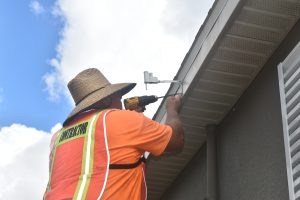It’s that time of year again when we can expect a thunderstorm to roll in mid-afternoon and pour for half an hour before dissipating as quickly as it came. These rains provide relief to thirsty lawns that spend the rest of the day baking in the sun. However, that is only half the story.
Unfortunately, these same rains can provide too much water if irrigation times are not adjusted to compensate, especially if previously raised for the high water needs of late spring/early summer. According to a study done by Romero and Dukes (2011), the May average irrigation requirement for the Tampa area is just under 6 inches, which comes out to 1.5 inches per week. In contrast, in July, the irrigation requirement for the same area is just under 2 inches, which is only half an inch per week. Although plants need more water now because they are actively growing, our typical precipitation mostly covers it. For this reason, weeds, fungi, and diseases take advantage of plant stress and can become widespread once the summer rains begin.
So, what can you do to ensure your lawn isn’t overwatered?

First, make sure your rain sensor is in the correct location and working. Sensors should be out in the open to collect rain, not underneath overhangs or trees. Testing is easier with two people since one likely needs to climb a ladder to get to the sensor. Each model works slightly differently, but the most common type has a button on top for testing. Once you have manually turned on the sprinklers, push and hold the button. If your sprinklers turn off, you know your sensor is working. If not, you may need a new sensor. Contact your water utility to see if they are offering free replacement sensors or you can visit SavePolkWater.org to see what sort of incentives are available in your area. Remember, a working rain sensor is required by law in Florida for all properties with automatic irrigation systems.
Second, you can look for physical signs that your lawn is getting too much water. For instance, does water run off your lawn when you turn on your sprinklers? Do you have water-loving plants like dollar weed infiltrating your grass? Other indicators include fungus, root rot, yellowing grass, thatch, and the death of patches of grass. If you have these problems, you should consider making changes to your timer.
Third, make sure your irrigation controller is only set for the days prescribed in your watering restrictions. Through most of Florida, water restrictions are year-round as prescribed by the water management district, unless local municipalities have more stringent rules. Be careful you don’t accidentally have more than one program running. You can find out by pressing the “program” button while setting up the run times.
Alternatively, you can run your sprinklers manually only when there is no rain forecasted within the next day, nor has it rained within the last couple of days. You are still only allowed to water on your authorized days, but you can set a reminder on your phone to check your lawn for water stress and decide if it needs a drink. Symptoms of water stress include turning an unusual bluish color, the leaf blades folding over, or footprints not disappearing. Be sure to only water before 10 AM or after 4 PM to minimize water lost to evaporation.
For more information, contact UF/IFAS Extension Polk County at (863) 519-1041 or visit us online at http://sfyl.ifas.ufl.edu/polk. The Plant Clinic is open Monday-Friday, 9:00 am-4:00 pm to answer your gardening and landscaping questions. Visit us in person, give us a call, or email us at polkmg@ifas.ufl.edu.
An Equal Opportunity Institution.
 0
0
